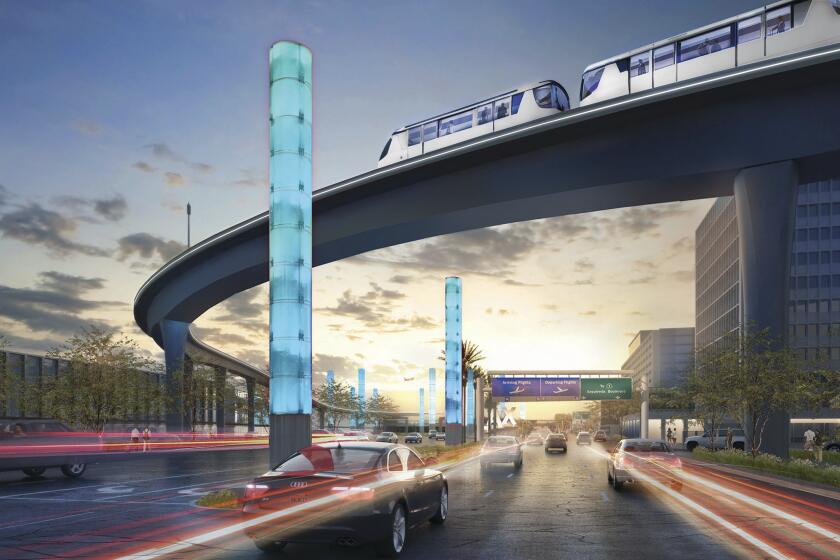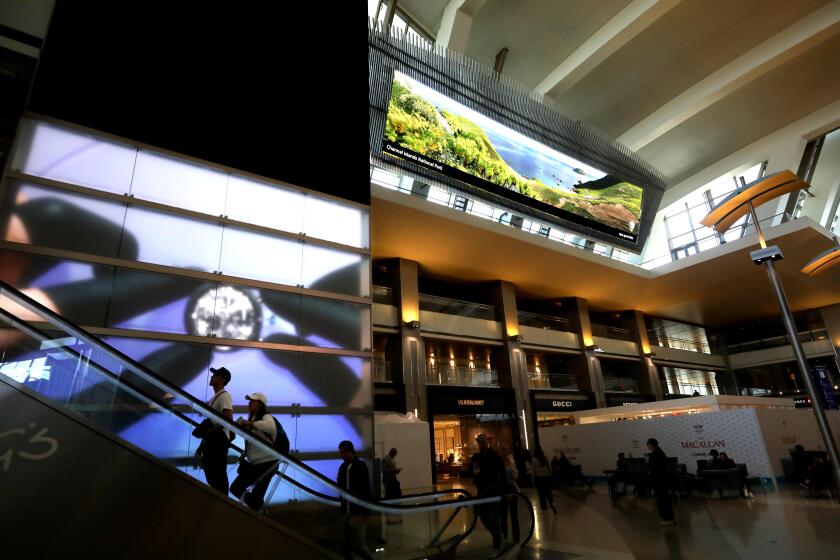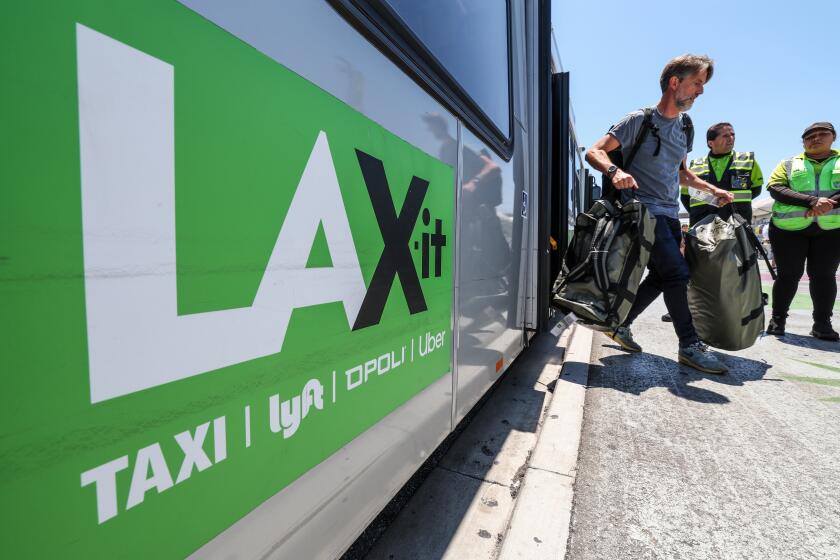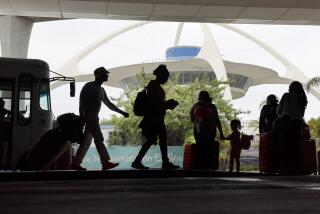L.A. waited so long it seemed like a fantasy. But it’s actually coming: A rail connection to LAX

- Share via
Gerardo Ramirez flew into Los Angeles from Mexico City on Thursday and was surprised to learn that he couldn’t easily access a rail line from the main airport of a major city — something he’s come to expect in his travels.
“I’ve been in many cities around the world, where public transportation is well connected,” said Ramirez, 24. “It’s my first time here in L.A., and I don’t know why I can’t find public transit to connect me to a train.”
This has been the city’s transit riddle for decades.
In the 1970s, as L.A. County’s population boomed and its traffic became infamous, civic leaders began pushing for a light rail system to connect the sprawling region. With ever more passengers pouring through Los Angeles International Airport, planners saw it as an obvious destination as workers broke ground for the first line — the Blue Line between Long Beach and downtown — in 1985.
Nearly 40 years later, as hundreds of thousands of residents and tourists spill onto 1 World Way each week, rail still has not made it to one of the busiest airports in the world. You can take a Metro train to North Hollywood or Santa Monica or El Segundo or Azusa. Just not to LAX.
City officials and transit experts have long called this an embarrassing misstep.
The allocation will settle $550 million in past claims over the long-awaited Automated People Mover train at Los Angeles International Airport.
But now that elusive air-rail link is almost here. After the long-awaited Automated People Mover train opens in 2026, it will connect LAX to the Metro rail system from the K Line and the C Line.
“For this particular place, which draws literally millions of trips, we’re going to see people using that option,” said Genevieve Giuliano, interim dean of the Sol Price School of Public Policy at USC. “Once this connection actually gets completed … I think you’re going to really see a difference in the way people access the airport.”
Once running, Metro riders will be able to board the people mover at the upcoming LAX/Metro Transit Center Station at Aviation Boulevard and 96th Street directly from the K Line or C Line, formerly known as the Green Line. That route will change for the first time since it opened in 1995 — instead of heading south from El Segundo, the C Line will curve upward and end at the transit center and the K Line will run on the tracks that extend to Redondo Beach.
“We don’t often do this with rail lines — snipping pieces of them and putting them into other lines. Usually we’re just extending a line or opening a new line. So this one’s a little bit trickier, but it’s all a good outcome,” said Joseph Forgiarini, senior executive officer of service development, scheduling and analysis at Metro.
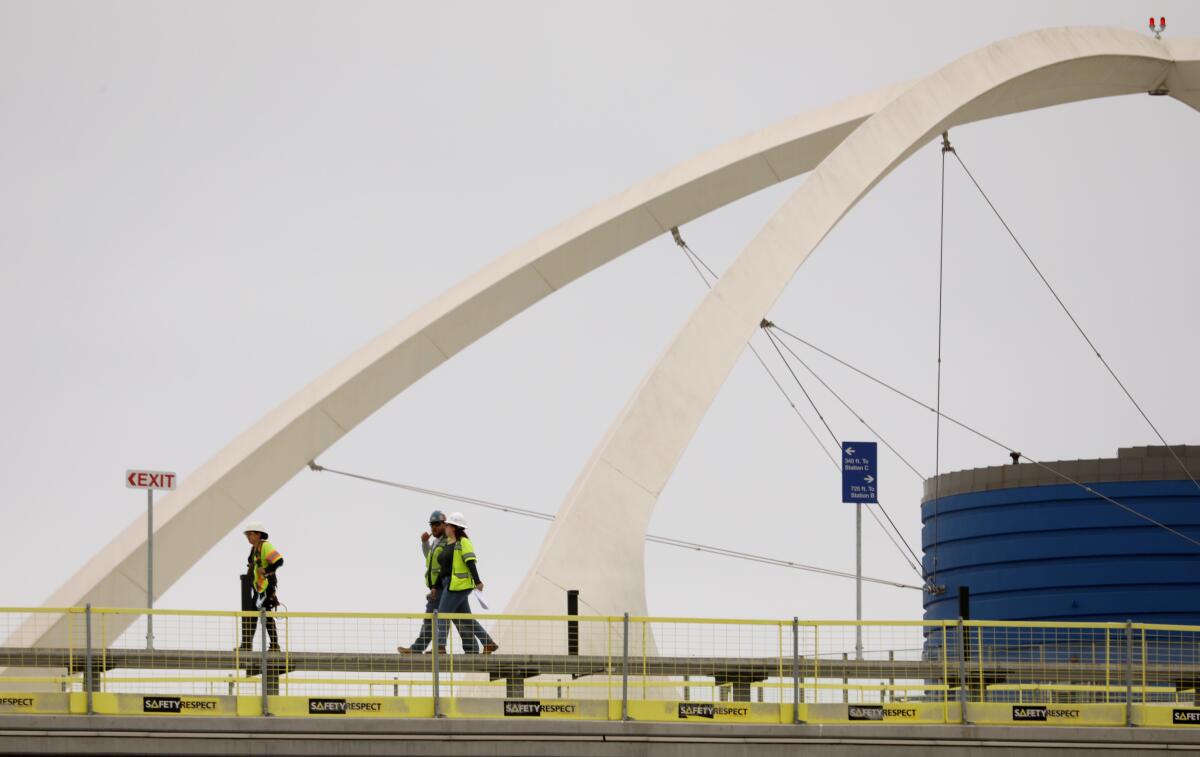
Someone traveling from downtown to LAX will have two ways — the A Line to the C Line or the E Line to the K Line — to get to the transit center, where they’d board a people mover train upstairs to the terminals.
Residents in places such as Redondo Beach, Norwalk, Leimert Park and Inglewood will be able to make it to LAX on one Metro train, while those in Long Beach, Santa Monica, Pasadena, Azusa and East L.A. will need to take two. LAX to Hollywood or Universal Studios would take three trains.
The total budget for the people mover project is $3.34 billion; the budget for the transit hub is $900 million.
Most major airports offer a light rail connection typically accessed by a people mover. At LAX, a variety of factors stalled that reality.
In the 1990s, Metro’s then-Green Line was expected to offer a direct connection to LAX but ended two miles short of the terminals. At its closest, it’s less than 900 yards from the runways.
Airport officials were reportedly concerned over potential lost parking profits if travelers had a Metro option. According to media reports in 1990, LAX officials raised the cost of parking to bring in more parking revenue, which helped lower the cost of landing fees for airlines.
There was also pushback from the Federal Aviation Administration, which raised concerns in 1991 about the railway’s potential interference with antenna systems and obstruction of airplanes’ line of sight. A more than 200-page study commissioned out of Ohio University provided a solution to avoid either of those scenarios by reconfiguring the rail line, records show. But in 1992, transportation planners dropped the extension over budget concerns, according to a 1995 Times report.
Competing interests over the use of taxpayer dollars were also at play. Bypassing the airport meant the line could continue farther south to Redondo Beach.
“The building of the Green Line is a major step forward,” MTA Chief Executive Officer Franklin E. White said in 1995. “The fact that it doesn’t tie in at the moment to the airport doesn’t mean that it wasn’t a good idea.”
A $30-billion overhaul promises to make the experience better for travelers ahead of the 2028 Olympics and the airport’s centennial. Until then, travelers continue to endure chaos.
But as the horseshoe of LAX became ever more choked with traffic, the question of how Metro would link to the airport became more urgent. In 2014, city and transit leaders renewed the debate.
According to Metro and Los Angeles World Airports board meeting archives, officials cited ridership projections, cost and potential safety concerns and decided to move forward with plans for an elevated people mover train that would connect travelers to Metro, without tunneling underground to bring Metro inside the airport or creating new construction in the surrounding area that would further aggravate traffic. A people mover, which had also been discussed as a possibility for a Green Line connection, is an electric driverless train that can make more frequent trips than a Metro train.
Former County Supervisor Zev Yaraslovsky, who was at the meeting in 2014, said the airport’s design presented its own obstacle when tackling the question of how to get rail to LAX.
“It might have been cleaner, it might have been a little more efficient if we had started this from scratch and just leveled the airport and started all over again. But obviously that was not an option,” he said.
“So you work around the limitations that you have and the barriers that you have. But to not have public transportation at one of the busiest airports in the world, in the second largest city in America — an international city, which has air traffic that’s coming in from, you know, six continents every day — is a major faux pas.”
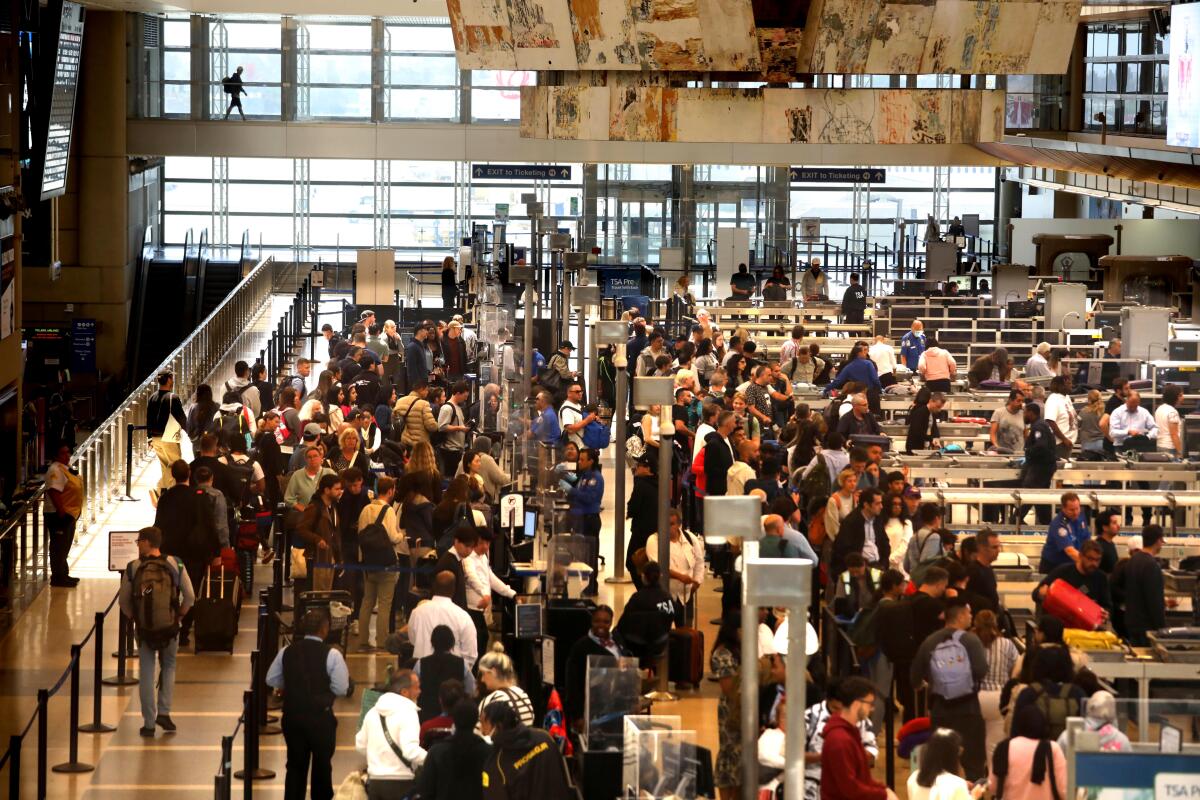
More than 10 years later, the people mover project is still underway. It was expected to open in 2023 but was significantly delayed due to disagreements between the airport and the contractor. The train is slated to open in January 2026 — before the World Cup and the 2028 Olympics, airport and city officials say.
Until then, the lack of an airport Metro connection continues to mystify visitors.
Eileen Gomez assumed that she could find the Metro access straight from the airport in Los Angeles, like she would up north in San Francisco. When she flew in for the first time, she was surprised to discover that was far from the case.
“Considering how big L.A. is and how many things it has, in general, I honestly expected some sort of transit,” said Gomez, 25, who was in town from Salinas to see a concert with friends. Instead, she and her travel companions made their way to the “LAX-it” lot, with needed guidance from an airport worker, to hail an Uber. She would have preferred a Metro connection to exit the airport.
When it opens, the transit hub will also include a bus plaza, bicycle parking, customer service center and a passenger pick-up and drop-off area for all travelers who want to avoid the congestion in the horseshoe.
The center is one of six stations where travelers will be able to board the people mover — three will be located inside the airport area; one will connect to a new consolidated rental car facility; and one will connect to a parking lot area, where the rideshare lot will likely relocate.
Metro riders must currently rely on a bus for the last leg of their airport journey, subject to the whims of traffic. Officials have said that a people mover train will run 24/7 and every two minutes from 9 a.m. to 11 p.m., and that an end-to-end trip will take less than 10 minutes.
LAX-it has bedeviled travelers since it opened as a temporary ride-hail zone in 2019, preventing them from hailing a cab, Lyft or Uber outside terminals. The airport plans to open a new lot in 2026, connected to the airport by the upcoming People Mover.
Airport officials and transportation experts believe the 2.25-mile train will significantly reduce traffic at the airport.
“When the trains are essentially running every couple of minutes, that tends to reduce the transfer burden,” Brian Taylor, director of the Institute of Transportation Studies at UCLA, said about the waiting time. “When the trains run very frequently, people start to think of them less like ‘I’m sitting here waiting for a bus,’ and more like, ‘I’m kind of getting on a moving sidewalk.’”
The expectation among transit officials is that even if Angelenos don’t change their habits, tourists and airport workers will likely use the people mover to leave the clogged airport.
Workers interviewed said they didn’t know if they would change their commuting habits, citing a need for more information about logistics.
“We’re the last people to know what’s going on at the airport,” said Oscar Antonio, 63, adding that in order to get to the closest Metro stop near his residence, he would still have to drive. Other workers voiced concerns about crime on the trains.
Tourists were more sanguine. A group of visitors from Tampa for Fashion Week said they would take Metro if it connected to LAX.
“I feel like any kind of public transportation that just makes getting around easier and cheaper and more accessible to people is always a win,” said Kate Barry, 24, who is originally from Chicago, where she regularly took public transit.
Transportation experts have said that the effects of traffic to and from LAX affects drivers throughout Los Angeles’ freeway system, and a transit option that cuts down on those trips is likely to have a ripple effect across the city.
“There’s certainly the value to the airport that’s critical,” said Darin Chidsey, deputy executive director and chief operating officer of Southern California Assn. of Governments. “But being able to have a viable and efficient and easy transit option that the [people mover] offers is going to provide great benefits well beyond the boundaries of LAX.”
More to Read
Sign up for This Evening's Big Stories
Catch up on the day with the 7 biggest L.A. Times stories in your inbox every weekday evening.
You may occasionally receive promotional content from the Los Angeles Times.
